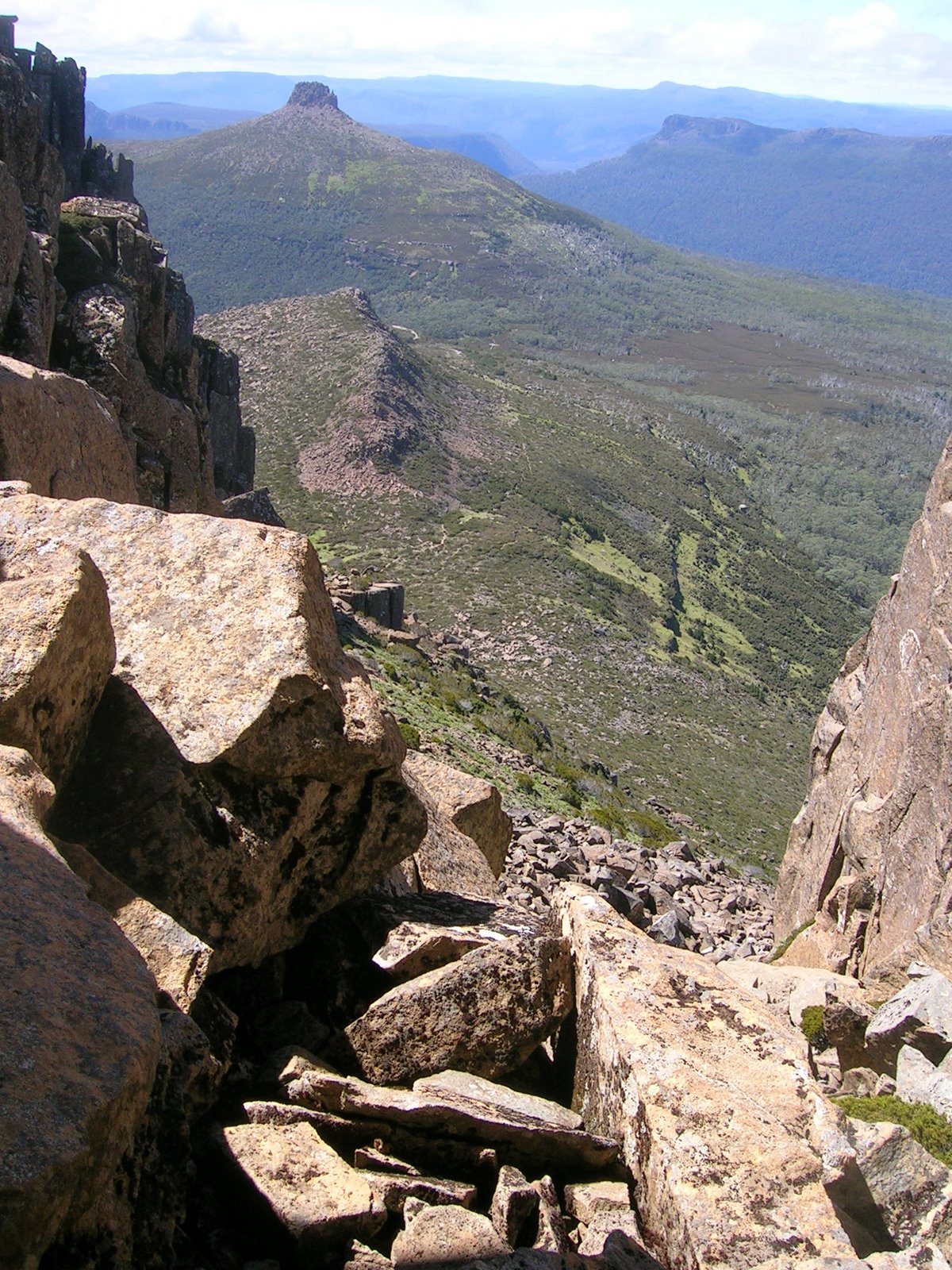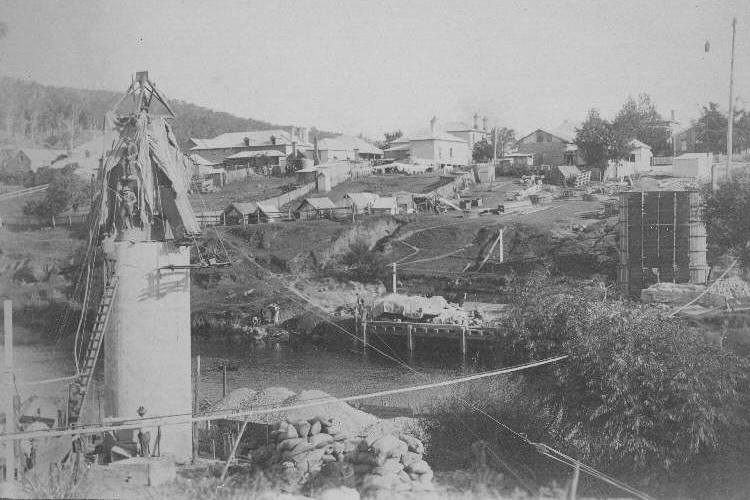|
Glenugie Peak
Glenugie Peak, also known as Mount Elaine or as Glen Ugie Peak, is a mountain that forms part of the ridge surrounding the Clarence Moreton Basin. It is situated in the Northern Rivers region of New South Wales, Australia, and has an elevation of above sea level. The mountain is located near the Pacific Highway, south of the town of and approximately west north-west of the locality of Calamia. Glenugie Peak is known as ''Gunayjun'' to the local Gumbaynggirr people. Features and location Glenugie peak is composed mainly of Cenozoic-aged dolerite The Dolerites of Glenugie Peak were extruded from the Grafton Formation. The Grafton Formation is a series of sedimentary rocks, laid down between the late Jurassic and early Cretaceous periods. Glenugie Peak is noted by Matthew Norman for its dry rainforest in a gully which includes a number of rare species of trees, as well as the Yellow Box, which is more often associated with areas west of the Great Dividing Range The Grea ... [...More Info...] [...Related Items...] OR: [Wikipedia] [Google] [Baidu] |
Cenozoic Era
The Cenozoic ( ; ) is Earth's current geological era, representing the last 66million years of Earth's history. It is characterised by the dominance of mammals, birds and flowering plants, a cooling and drying climate, and the current configuration of continents. It is the latest of three geological eras since complex life evolved, preceded by the Mesozoic and Paleozoic. It started with the Cretaceous–Paleogene extinction event, when many species, including the non-avian dinosaurs, became extinct in an event attributed by most experts to the impact of a large asteroid or other celestial body, the Chicxulub impactor. The Cenozoic is also known as the Age of Mammals because the terrestrial animals that dominated both hemispheres were mammalsthe eutherians (placentals) in the northern hemisphere and the metatherians (marsupials, now mainly restricted to Australia) in the southern hemisphere. The extinction of many groups allowed mammals and birds to greatly diversify so that l ... [...More Info...] [...Related Items...] OR: [Wikipedia] [Google] [Baidu] |
List Of Mountains Of Australia
This is a list of mountains in Australia. Highest points by state and territory List of mountains in Australia by topographic prominence This is a list of the top 50 mountains in Australia ranked by topographic prominence. Most of these peaks are the highest point in their areas. Australian Capital Territory The following is a list of mountains and prominent hills in the Australian Capital Territory in order, from the highest peak to the lowest peak, for those mountains and hills with an elevation above : New South Wales Queensland South Australia Tasmania Victoria Western Australia * Carnarvon Range * Mount Augustus (1105m) * Mount Beadell * Darling Range ** Mount Dale ** Mount Cooke * Hamersley Range ** Mount Meharry (at 1,249 metres above sea level, the highest peak in Western Australia) ** Mount Bruce (1,221 m; the second highest peak in WA) ** Mount Nameless/Jarndunmunha 1,115 m * Wunaamin Miliwundi Ranges, formerly King Leopold Ranges * ... [...More Info...] [...Related Items...] OR: [Wikipedia] [Google] [Baidu] |
North Coast Railway Line, New South Wales
The North Coast Line is the primary rail route in the Mid North Coast and Northern Rivers regions of New South Wales, Australia, and forms a major part of the Sydney–Brisbane rail corridor. The line begins at Maitland and ends at Roma Street railway station in Brisbane, although freight services terminate at the yard at Acacia Ridge on the outskirts of Brisbane. Along the way, the railway passes through the towns of Dungog, Gloucester, Wingham, Taree, Kendall, Wauchope, Kempsey, Macksville, Nambucca Heads, Urunga, Sawtell, Coffs Harbour, Grafton, Casino and Kyogle. After the standard gauge line ends at Acacia Ridge, it forms a dual gauge line into Brisbane, running alongside parts of the Beenleigh railway line. Since the Main Northern Line was closed north of Armidale in 1988, the North Coast line is now the only route between Sydney and Queensland. With the closure of former branches to Dorrigo (1972) and Murwillumbah (2004) there are no operating branches off th ... [...More Info...] [...Related Items...] OR: [Wikipedia] [Google] [Baidu] |
Great Dividing Range
The Great Dividing Range, also known as the East Australian Cordillera or the Eastern Highlands, is a cordillera system in eastern Australia consisting of an expansive collection of mountain ranges, plateaus and rolling hills, that runs roughly parallel to the east coast of Australia and forms the fifth-longest land-based mountain chain in the world, and the longest entirely within a single country. It is mainland Australia's most substantial topographic feature and serves as the definitive watershed for the river systems in eastern Australia, hence the name. The Great Dividing Range stretches more than from Dauan Island in the Torres Strait off the northern tip of Cape York Peninsula, running the entire length of the eastern coastline through Queensland and New South Wales, then turning west across Victoria before finally fading into the Wimmera plains as rolling hills west of the Grampians region. The width of the Range varies from about to over .Shaw, John H., ''Col ... [...More Info...] [...Related Items...] OR: [Wikipedia] [Google] [Baidu] |
Eucalyptus Melliodora
''Eucalyptus melliodora'', commonly known as yellow box, honey box or yellow ironbark, is a species of medium-sized to occasionally tall tree that is Endemism, endemic to south-eastern, continental Australia. It has rough, flaky or fibrous bark on part or all of the trunk, smooth greyish to yellowish bark above. The adult leaves are lance-shaped to egg-shaped, the flower buds are arranged in groups of seven and the fruit is more or less hemispherical. Description ''Eucalyptus melliodora'' is a tree that typically grows to a height of and forms a lignotuber. The bark is variable ranging from smooth with an irregular, short stocking, to covering most of the trunk, fibrous, dense or loosely held, grey, yellow or red-brown, occasionally very coarse, thick, dark brown to black. The smooth bark above is shed from the upper limbs to leave a smooth, white or yellowish surface. Young plants and coppice regrowth have lance-shaped to elliptic leaves that are long and wide and Petiole (b ... [...More Info...] [...Related Items...] OR: [Wikipedia] [Google] [Baidu] |
Rainforest
Rainforests are characterized by a closed and continuous tree canopy, moisture-dependent vegetation, the presence of epiphytes and lianas and the absence of wildfire. Rainforest can be classified as tropical rainforest or temperate rainforest, but other types have been described. Estimates vary from 40% to 75% of all biotic species being indigenous to the rainforests. There may be many millions of species of plants, insects and microorganisms still undiscovered in tropical rainforests. Tropical rainforests have been called the "jewels of the Earth" and the " world's largest pharmacy", because over one quarter of natural medicines have been discovered there. Rainforests as well as endemic rainforest species are rapidly disappearing due to deforestation, the resulting habitat loss and pollution of the atmosphere. Definition Rainforest are characterized by a closed and continuous tree canopy, high humidity, the presence of moisture-dependent vegetation, a moist layer of lea ... [...More Info...] [...Related Items...] OR: [Wikipedia] [Google] [Baidu] |
Cretaceous
The Cretaceous ( ) is a geological period that lasted from about 145 to 66 million years ago (Mya). It is the third and final period of the Mesozoic Era, as well as the longest. At around 79 million years, it is the longest geological period of the entire Phanerozoic. The name is derived from the Latin ''creta'', "chalk", which is abundant in the latter half of the period. It is usually abbreviated K, for its German translation ''Kreide''. The Cretaceous was a period with a relatively warm climate, resulting in high eustatic sea levels that created numerous shallow inland seas. These oceans and seas were populated with now- extinct marine reptiles, ammonites, and rudists, while dinosaurs continued to dominate on land. The world was ice free, and forests extended to the poles. During this time, new groups of mammals and birds appeared. During the Early Cretaceous, flowering plants appeared and began to rapidly diversify, becoming the dominant group of plants across the Earth b ... [...More Info...] [...Related Items...] OR: [Wikipedia] [Google] [Baidu] |
Jurassic
The Jurassic ( ) is a Geological period, geologic period and System (stratigraphy), stratigraphic system that spanned from the end of the Triassic Period million years ago (Mya) to the beginning of the Cretaceous Period, approximately Mya. The Jurassic constitutes the middle period of the Mesozoic, Mesozoic Era and is named after the Jura Mountains, where limestone strata from the period were first identified. The start of the Jurassic was marked by the major Triassic–Jurassic extinction event, associated with the eruption of the Central Atlantic magmatic province, Central Atlantic Magmatic Province. The beginning of the Toarcian Stage started around 183 million years ago and is marked by an extinction event associated with widespread Anoxic event, oceanic anoxia, ocean acidification, and elevated temperatures likely caused by the eruption of the Karoo-Ferrar, Karoo-Ferrar large igneous provinces. The end of the Jurassic, however, has no clear boundary with the Cretaceous and i ... [...More Info...] [...Related Items...] OR: [Wikipedia] [Google] [Baidu] |
Dolerite
Diabase (), also called dolerite () or microgabbro, is a mafic, holocrystalline, subvolcanic rock equivalent to volcanic basalt or plutonic gabbro. Diabase dikes and sills are typically shallow intrusive bodies and often exhibit fine-grained to aphanitic chilled margins which may contain tachylite (dark mafic glass). ''Diabase'' is the preferred name in North America, while ''dolerite'' is the preferred name in the rest of the English-speaking world, where sometimes the name ''diabase'' refers to altered dolerites and basalts. Some geologists prefer to avoid confusion by using the name ''microgabbro''. The name ''diabase'' comes from the French ', and ultimately from the Greek - meaning "act of crossing over, transition". Petrography Diabase normally has a fine but visible texture of euhedral lath-shaped plagioclase crystals (62%) set in a finer matrix of clinopyroxene, typically augite (20–29%), with minor olivine (3% up to 12% in olivine diabase), magnetite (2%), and ... [...More Info...] [...Related Items...] OR: [Wikipedia] [Google] [Baidu] |
Gumbaynggirr Language
Gumbaynggir (also spelled Gumbaingari, Kumbainggar, Kumbaingeri, Gambalamam, and also called Baanbay) is an Australian Aboriginal language spoken by the Gumbaynggirr people, who are native to the Mid North Coast of New South Wales. History and description Gumbaynggir is the only surviving language in the Gumbaynggiric family of Pama–Nyungan stock. It has a binary way of counting numbers. Phonology Vowels Consonants Voiced stops may also be realised as voiceless sounds , k, c, t when occurring in intervocalic positions. Revitalisation Organised revitalisation of Gumbaynggir has been under way since 1986 when Muurrbay Aboriginal Language and Culture Co-operative was founded at Nambucca Heads. Classes in Gumbaynggir are taught through the North Coast Institute of TAFE up to Certificate II level. Muurrbay and Many Rivers Aboriginal Language Centre (MRALC) supports Aboriginal language revitalization through activities that include: * Providing access to linguistic ... [...More Info...] [...Related Items...] OR: [Wikipedia] [Google] [Baidu] |
New South Wales
) , nickname = , image_map = New South Wales in Australia.svg , map_caption = Location of New South Wales in AustraliaCoordinates: , subdivision_type = Country , subdivision_name = Australia , established_title = Before federation , established_date = Colony of New South Wales , established_title2 = Establishment , established_date2 = 26 January 1788 , established_title3 = Responsible government , established_date3 = 6 June 1856 , established_title4 = Federation , established_date4 = 1 January 1901 , named_for = Wales , demonym = , capital = Sydney , largest_city = capital , coordinates = , admin_center = 128 local government areas , admin_center_type = Administration , leader_title1 = Monarch , leader_name1 = Charles III , leader_title2 = Governor , leader_name2 = Margaret Beazley , leader_title3 = Premier , leader_name3 = Dominic Perrottet (Liberal) , national_representation = Parliament of Australia , national_representation_type1 = Senat ... [...More Info...] [...Related Items...] OR: [Wikipedia] [Google] [Baidu] |








